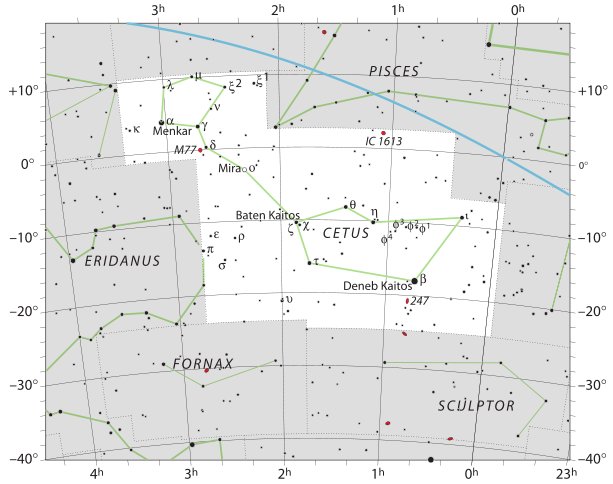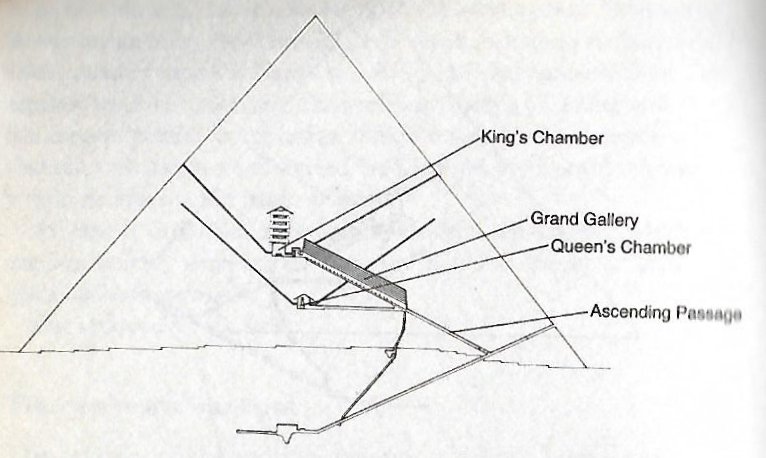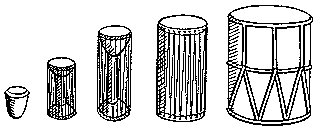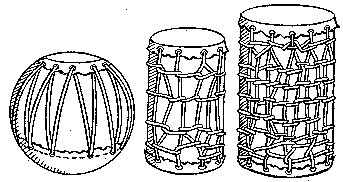It seems possible that when Makoi went by himself
withershins around the whole island it was an allusion to the
last day in the Sun calendar, that day which was between day
364 and the first day of the new year (i.e. the day in the
expression 'a year and a day').
... Another name for Mercury was Hermes and Hermes
Trismegisthos (thrice-mighty) could have referred to the
fact that there were 3.14 * 115.88 = 364.0 days for the
cycle of the Earth around the Sun. Although the calendar has
365 days for a year this is due to the fact that the Earth
has to turn around an extra day in order to compensate for
how the direction to the Sun changes during a year
...
... You are the one who shall stay here. We, on the other
hand, have to turn around. Makoi replied, All right
with me! Then Ira continued to speak to Makoi:
Tomorrow, when it grows light, set out and name the places
beginning with Apina. Makoi replied, How shall
I give the names? Again Ira spoke, In Hiva are
the names that are to be taken to name (the places of the
new land). It grew light and Makoi got up. He set out
and came to Apina. When he arrived there, he gave the
name This is Apina Iti, this is Rapa Kura. He went on
and came to Hanga O Ua. He gave the name This is
Hanga O Ua of the Beautiful Wave (vave renga).
Makoi went on, giving names, until he had made a
(complete) circle around both sides (of the island). In
Apina Nui a stone (maea) was erected, saying that
the naming was done on a (round) trip during a single day
... [E:37]
... If we could equate mulApin
(Triangulum) with the Easter Island location Apina Nui,
then we could guess Apina Iti was the Southern
Triangle.
The Polynesians could not end a word with the consonant 'n'
and therefore the famous mulAPIN should have become
the Easter Island place Apina ...

We should notice that Metallah (α Trianguli) was located at
the same right ascension line as Polaris, and that ε
Trianguli would have risen heliacally 3 days later:
|
 |
 |
225 |
 |
28 |
 |
|
Ca5-31 (136) |
Ca5-32 |
Ca13-20 (363) |
Ca14-29 (392) |
|
TALITHA AUSTR
(*136) |
9h (*137.0) |
DZANEB (*362) |
POLARIS (*392
- *366) |
|
21h (*319.6) |
DRAMASA
(*320.0) |
PHEKDA (*179) |
BENETNASH
(*391 - *183) |
|
256 = 16 * 16
= 227 + 29 |
 |
 |
 |
 |
 |
|
Ca14-29 |
Cb1-1 |
Cb1-2 |
Cb1-3 |
Cb1-4 (396) |
| te rima |
E
tupu - ki roto |
o te hau tea |
ki te henua -
te maro |
|
ANA-NIA-10 (Pillar-to-fish by)
χ
Ceti (26.1),
POLARIS
= α Ursae Minoris, BATEN KAITOS = ζ Ceti
(26.6),
METALLAH
= α Trianguli
(26.9) |
Al Sharatain-1 /
Ashvini-1 /
Bond-16 (Dog) /
Mahrū-sha-rishu-ku-1 (Front of the Head of Ku)
SEGIN =
ε
Cassiopeia, MESARTHIM =
γ
Arietis,
ψ
Phoenicis (27.2),
SHERATAN (Pair of Signs)
=
β
Arietis,
φ
Phoenicis (27.4)
*351.0 = *27.4 - *41.4 |
ι Arietis (28.0), λ Arietis (28.2), υ Ceti
(28.8) |
ALRISHA (The Knot) = α Piscium, χ Phoenicis (29.2),
ε
Trianguli (29.4),
ALAMAK (Caracal)
= γ Andromedae
(29.7)
*353.0 = *29.4 - *41.4 |
Arku-sha-rishu-ku-2 (Back of the Head of Ku)
2h (30.4)
κ
Arietis (30.3),
HAMAL (Sheep)
=
α
Arietis
(30.5)
ALKES (α
Crateris)
*354.0 = *30.4 - *41.4 |
 |
|
16 |
April 17
(107) |
18 |
19 (80 + 29) |
20 |
|
20
(79) |
'March 21 |
22 |
23 |
24 |
|
... Ecclesiastically, the
equinox is reckoned to be on 21 March (even
though the equinox occurs, astronomically
speaking, on 20 March [*364] in most years) ... |
|
6 (65) |
"March 7 |
8 |
9 |
10 (*354) |

 |
Then the drums were sounding and the sky was moving - the
tiny star η was at the nose of Aries and at the back of the
head of Cetus was
ξ¹:
|
FEBR
16 |
17
(413 = 14 * 29½) |
 |
 |
|
Cb1-5 |
Cb1-6
(6 + 392) |
|
rutua - te pahu
- rutua te maeva |
|
DELTOTUM (Δ) = β Trianguli (31.2), ι Trianguli (31.7), η Arietis (31.9) |
ξ¹ Ceti (32.1) |
|
April
21 (111) |
22 |
|
Julian
equinox |
'March 26 (85) |
|
"March
11 (*355) |
12 (436 = 365 + 71) |

Here we should return to the beginning of the A
tablet and guess that Ab1-1 could be referring
to the same position as Cb1-1, because that
might be concluded from the words of Metoro:
|
FEBR 12 (408) |
13 |
14 |
15
(46) |
 |
 |
 |
 |
|
Ab1-1 |
Ab1-2 |
Ab1-3 |
Ab1-4 |
|
Te hoea |
rutua
te pahu |
rutua te maeva |
atua
rerorero - atua ata tuu |
|
Ata 1. Dawn,
first light before sunrise; ku-hamu-á
te ata, dawn has broken;
ku-tehe-á te ata, it's already dawn
(lit.: the lights have flown). 2.
Particle inserted between the imperative
prefix ka and the verb to signify
'well, carefully, intelligently':
ka-ata-hakarivariva, prepare it
well. Between the prefix e and
kahara it expresses 'to make sure
that, to take good care that...' :
e-ata-kahara koe o oona, be careful
not to get dirty; e-ata-kahara koe o
kori te moa o te tahi pa, be sure
not to steal chickens of another
property. 3. More: iti, small;
ata iti, smaller; he-ata-ata
iti-iti ró, the smallest of all.
Vanaga. Âta 1. Shadow:
he-veveri te poki, ana tikea toona âta,
the child is frightened at seeing
his shadow; person's reflection (in
mirror, in water): he âta oou-á,
it's your own reflection. 2. To be
frightened by a shadow: he-âta te
îka, the fish are frightened (and
they flee) by people's shadows. Vanaga.
1. Image, picture, portrait, design; to
draw, to paint (shadow sense). P Mgv:
ata, image, likeness, portrait,
shadow of a human being, form, shape,
appearance, imprint, impression. Mq.:
ata, image, statue, portrait,
shadow, surface; to design, to mark.
Ta.: ata, shade, shadow
appearance, form, representation of an
object, cloud, cloudy. 2. Transparency,
end of day, sunset (bright sense); e
ata, red clouds; ku ata,
transparent; ata mea, ata tea,
ata tehe, dawn, daybreak,
sunrise; ataata, end of day,
sunset. P Mgv.: ata, morning or
evening twilight, daybreak, dawn; ata
haihai, evening twilight, a
beautiful sunset; ataiai,
twilight, clouds red with the sunset;
atakurakura, a beautiful sunrise or
sunset; atareureu, dawn, the
first peep of day, morning twilight.
Mq.: ata, to appear, to rise, to
shine (of stars); ata uá, morning
twilight; ataata, diaphanous,
transparent. Ta.: ata, twilight.
3. A designation of space; ata
hakahohonu, abyss; ata hakaneke
mai, nearby, close at hand; ata
tapa, lateral, marginal. 4 ? Ata
kimikimi, to inquire; ata puo,
to hill a plant; ata ui, to
examine, to taste. Churchill.
Atahenua (ata 3 - henua
1), landscape, countryside. Atakai:
1. Generous, hospitable, beneficent,
indulgent, liberal, obliging;
prodigality, indulgence; rima atakai,
benevolent, generous, open-handed; gift,
liberality. 2. Calm, unperturbed,
grateful. Churchill. Ata-ta T,
evening (? ataata). Atatehe
(ata 2 - tehe 1), dawn;
popohaga atatehe, morning, early in
the morning. Churchill. |
|
Al Sharatain-1 /
Ashvini-1 /
Bond-16 (Dog) /
Mahrū-sha-rishu-ku-1 (Front of the Head of Ku)
SEGIN =
ε
Cassiopeia, MESARTHIM =
γ
Arietis,
ψ
Phoenicis (27.2),
SHERATAN (Pair of Signs)
=
β
Arietis,
φ
Phoenicis (27.4)
*351.0 = *27.4 - *41.4 |
ι Arietis (28.0), λ Arietis (28.2), υ Ceti
(28.8) |
ALRISHA (The Knot) = α Piscium, χ Phoenicis (29.2),
ε
Trianguli (29.4),
ALAMAK (Caracal)
= γ Andromedae
(29.7)
*353.0 = *29.4 - *41.4 |
Arku-sha-rishu-ku-2 (Back of the Head of Ku)
2h (30.4)
κ
Arietis (30.3),
HAMAL (Sheep)
=
α
Arietis
(30.5)
ALKES (α
Crateris)
*354.0 = *30.4 - *41.4 |
|
...
The present limit of the celestial polar regions
can be defined from the declination of the star
γ Andromedae ... Its current place is at
declination 42º 05' N. In other words the
measure across the polar regions should be 2 *
(90º - 42º 05') = 2 * 47º 55' = 95º 50' or
around 96º. The width of the polar regions is
thus around 2 * 96º = 192º and 360 - 192 = 168 =
2 * 84 (→ Julian spring equinox) ... |
|
April 17
(80 + 27 = 107) |
18 |
19 |
20 |
|
'March 21 (0h) |
22 |
23 |
24 |
|
"March 7 |
8 |
9 |
10
(*354) |
However, this does not quite fit, because clearly
the words rutua te pahua in the C
text were not referring to the glyphs before
Ca1-5, whereas rutua te pahua in the
A text appear to point already to the day after the First Point of
Aries (Sheratan).
The sky should be
moving (rutua te maeva) at the Caracal - when the Full Moon
would have been at right ascension day *29.4
+ *365¼ / 2 = *212 = at Thuban.
... Thuban had been the
star at the North Pole when the great
Egyptian pyramids where built ... The star
could be seen, both by day and night, from
the bottom of the central passage of the
Great Pyramid of Cheops (Knum Khufu)
at Ghizeh, in 30° of north latitude, as also
from the similar points in five other like
structures; and the same fact is asserted by
Sir John Herschel as to the two pyramids at
Abousseir ...
... For some reason, too,
it had taken their fancy to place the Great
Pyramid almost exactly on the 30th parallel
at latitude 29º 58' 51". This, a former
astronomer royal of Scotland once observed,
was 'a sensible defalcation from 30º', but
not necessarily in error: For if the
original designer had wished that men should
see with their body, rather than their
mental eyes, the pole of the sky from the
foot of the Great Pyramid, at an altitude
before them of 30º, he would have had to
take account of the refraction of the
atmosphere, and that
would have necessitated the building
standing not at 30º but at 29º 58' 22' ...

Thus, presumably the drums were sounding
at the northern spring equinox - viz.
according to the A text in what could be
deduced as day 1 after
0h in Roman times ('March 22)
|
14 |
Wall |
Algenib (γ Pegasi) |
Porcupine |
March 22 (81) |
 |
and
according to the C text 3 days later =
the Julian equinox:
|
A |
'March 22 |
81 |
108 = 81 + 27 |
April 18 |
|
C |
'March 25 |
84 |
111 = 84 + 41 |
April
21 |


|













